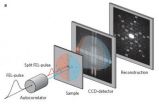Origins of the pandemic: Study reveals lessons of H1N1
How 'swine flu' overturned the understanding of pandemic outbreaks
2011-01-13
(Press-News.org) As H1N1 'Swine Flu' returns to the national headlines a new research paper reveals the key lessons about the origins of the 2009 pandemic. The paper, published today in BioEssays, reveals how the pandemic challenges the traditional understanding of 'antigenic shift' , given that the virus emerged from an existing influenza subtype.
"H1N1 emerged in February 2009 in Mexico and swept around the globe within 6 months." said Professor Hans Dieter Klenk from Philipps-Universität Marburg. "The conventional ideal is that pandemics are fuelled by new strands which emerge in the human population, yet it was because H1N1 did not conform to this ideal that its spread was so unexpected."
Professor Klenk's review of the pandemic focuses on antigens, substances which trigger the immune system when introduced into the body. Influenza viruses have two antigens, hemagglutinin (HA) and neuraminidase (NA).
"It was widely believed that a pandemic occurs when a virus with a new HA, or a new HA and a new NA that are not recognised by the human immune system emerges and spreads throughout the population," said Klenk, "this is known as antigenic shift."
While it was believed that this process has always involved the introduction of a new NA or HA subtype, the 2009 pandemic revealed that a pandemic can result from a shift within the lineages of the existing subtypes.
"There are 16 HA and 9 NA subtypes, which differ significantly, but contain multiple lineages that were always believed to be too similar to allow antigenic shift. However, this is exactly what occurred in 2009," said Klenk.
In the 2009 outbreak a strain of H1N1 containing new HA and NA lineages caused a pandemic even though H1N1 had already circulated through the human population, thus revealing an antigenic shift from within the same subtype.
"From studying the influenza outbreaks of 1918, 1957 or 1977 it looks as if pandemics only occur when a new HA or NA subtype enters the population. This meant that vaccination against the previous viruses offered little protection against infection by the new strain," concluded Klenk. "However, the 2009 outbreak overturns this rule, revealing that a pandemic may not depend on the introduction of a virus with a new HA subtype. This means future research should not simply monitor one or a few viruses and that plans to deal with pandemics must be flexible enough to handle the unexpected."
INFORMATION: END
ELSE PRESS RELEASES FROM THIS DATE:
2011-01-13
Major power outages are fairly infrequent, but when they happen they can result in billions of dollars in costs – and even contribute to fatalities. Now research from North Carolina State University has led to the development of an approach by which high-resolution power-system measurements, also referred to as Synchrophasors, can be efficiently used to develop reliable models of large power systems, which would help us keep an eye on their health.
Synchrophasors are real-time measurements of voltages and currents that provide a very high-resolution view of various complex ...
2011-01-13
Humans are notoriously bad at predicting their future happiness. A new study published in Psychological Science, a journal of the Association for Psychological Science, suggests that part of the reason for these mispredictions lies in failing to recognize the key role played by one's own personality when determining future emotional reactions.
The new evidence comes from Jordi Quoidbach, a psychological scientist at the University of Liege, Belgium. Quoidbach and Elizabeth Dunn, his collaborator at the University of British Columbia, found that our natural sunny or negative ...
2011-01-13
When we catch a cold, the immune system steps in to defend us. This is a well-known biological fact, but is difficult to observe directly. Processes at a molecular level are not only miniscule, they are often extremely fast, and therefore difficult to capture in action. Scientists at Helmholtz-Zentrum Berlin für Materialien und Energie (HZB) and the Technische Uni-versität Berlin (TUB) now present a method that takes us a good step towards producing a "molecular movie". They can record two pictures at such a short time interval that it will soon be possible to observe molecules ...
2011-01-13
"Snoring, sleep apnoea, and obesity-related respiratory difficulties are fairly common disorders that affect a large proportion of the population," according to Poul Jennum, Professor of Clinical Neurophysiology at the Center for Healthy Ageing at the University of Copenhagen Faculty of Health Sciences. He is head of the Danish Centre for Sleep Medicine, Glostrup Hospital, which treats patients from all over the country.
"Previous studies show that these disorders seriously affect quality of life, and our new studies show that people who snore violently, and particularly ...
2011-01-13
If you want to lose the kilos you've put on over Christmas, you may be interested in knowing that the hormones related to appetite play an important role in your likelihood of regaining weight after dieting. A new study confirms that people with the highest levels of leptin and lowest levels of ghrelin are more likely to put the centimetres they lost back on again.
Doctors often have to deal with patients who, after sticking to a slimming diet, have regained the kilos lost in just a short time – or weigh even more than they did before they started the diet. This is called ...
2011-01-13
Mice previously exposed to traumatic situations demonstrate a more persistent memory of fear conditioning - acquired by associating an acoustic stimulus with an aversive stimulus - and lack the ability to inhibit this fear. This phenomenon is similar to that of people who suffer from Post-Traumatic Stress Disorder (PTSD), an anxiety disorder which appears after being exposed to highly traumatic situations, such as a violent attack, a natural disaster or physical abuse.
In the study researchers verified that the 7,8-Dihydroxyflavone injected into mice previously subjected ...
2011-01-13
Looking deep into space, and literally peering back in time, is like experiencing the universe in a house of mirrors where everything is distorted through a phenomenon called gravitational lensing. Gravitational lensing occurs when light from a distant object is distorted by a massive object that is in the foreground. Astronomers have started to apply this concept in a new way to determine the number of very distant galaxies and to measure dark matter in the universe. Though recent progress has been made in extending the use of gravitational lensing, a letter published ...
2011-01-13
CHAMPAIGN, Ill. — Researchers report that they are the first to show in molecular detail how one gene evolved two competing functions that eventually split up – via gene duplication – to pursue their separate destinies.
The study, in the Proceedings of the National Academy of Sciences, validates a decades-old hypothesis about a key mechanism of evolution. The study also confirms the ancestry of a family of "antifreeze proteins" that helps the Antarctic eelpout survive in the frigid waters of the Southern Ocean.
"I'm always asking the question of where these antifreeze ...
2011-01-13
New research has found one of the smallest entities in the human genome, micro-RNA, could increase the risk of limb amputation in diabetic patients who have poor blood flow.
The study by Dr Andrea Caporali and colleagues in Professor Costanza Emanueli's research group in the Regenerative Medicine Section of the School of Clinical Sciences at the University of Bristol was funded by the Medical Research Council and is published online in Circulation: Journal of the American Heart Association.
The research group have shown in an experimental cell study that conditions ...
2011-01-13
ATHENS, Ohio (Jan. 12, 2011) – Some school social workers report that they don't feel equipped to handle incidents of cyberbullying among teens.
A new Ohio University-led survey of 399 members of the 11-state Midwest School Social Work Council found that while nearly all agreed that cyberbullying can cause psychological harm— including suicide—and deserved more attention from schools, just more than half felt empowered to deal with the issue. In contrast, other research on traditional bullying suggests that 86 percent of school staff members are confident in their ability ...
LAST 30 PRESS RELEASES:
[Press-News.org] Origins of the pandemic: Study reveals lessons of H1N1
How 'swine flu' overturned the understanding of pandemic outbreaks



